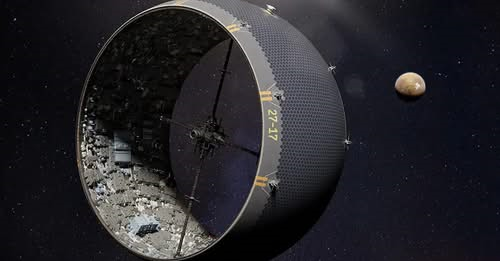
“Future Manhattan-Sized Asteroid Cities Could Host Human Life”
In a future where humanity has expanded beyond the boundaries of Earth, the concept of living in space has long been a staple of science fiction. However, recent advancements in space engineering and a growing interest in off-world colonization have reignited the idea that humans could one day live inside massive, Manhattan-sized asteroids transformed into self-sustaining megacities.
The vision involves hollowing out large asteroids and converting them into rotating habitats capable of supporting thousands, or even millions, of people. These space megacities would be designed to create Earth-like living conditions, with artificial gravity generated through centrifugal force as the asteroid rotates. Advanced life support systems would provide oxygen, water, and food, ensuring long-term habitability.
One of the key advantages of asteroid megacities is resource availability. Many asteroids are rich in essential elements such as iron, nickel, and even water ice, which could be utilized for construction, life support, and fuel. By building within asteroids rather than on planetary surfaces, spacefarers could avoid the challenges of extreme gravity wells and harsh surface conditions.
To construct these megacities, space agencies and private companies would need to develop technologies for asteroid capture, structural reinforcement, and climate control. The initial step would involve identifying suitable candidates—asteroids with stable orbits, sufficient size, and the right mineral composition.
Once captured, the asteroid’s interior would be hollowed out using a combination of automated mining drones and human oversight. The extracted materials could be repurposed for constructing the internal infrastructure, while the remaining shell would serve as a protective barrier against cosmic radiation and micrometeorite impacts.
Living spaces inside these asteroid cities could be designed to mimic Earth-like environments, complete with parks, rivers, and artificial sunlight powered by solar energy collectors on the asteroid’s surface. These habitats would offer a unique blend of urban and natural elements, making space life both comfortable and sustainable.
The potential for asteroid megacities extends beyond habitation. These structures could serve as industrial hubs, scientific research centers, and waypoints for deeper space exploration missions. Their strategic positioning in the asteroid belt or near Earth could also play a crucial role in interstellar trade and resource distribution.
While the concept remains speculative, ongoing advancements in space mining, habitat construction, and life support technology continue to bring asteroid megacities closer to reality. As humanity looks to expand its presence in the solar system, these floating metropolises could become the stepping stones for a truly spacefaring civilization.
The dream of living among the stars, once confined to the pages of science fiction, may one day become humanity’s next great achievement.
I’m in the mood for something sweet and spicy… you? – https://rb.gy/es66fc?blekeelm